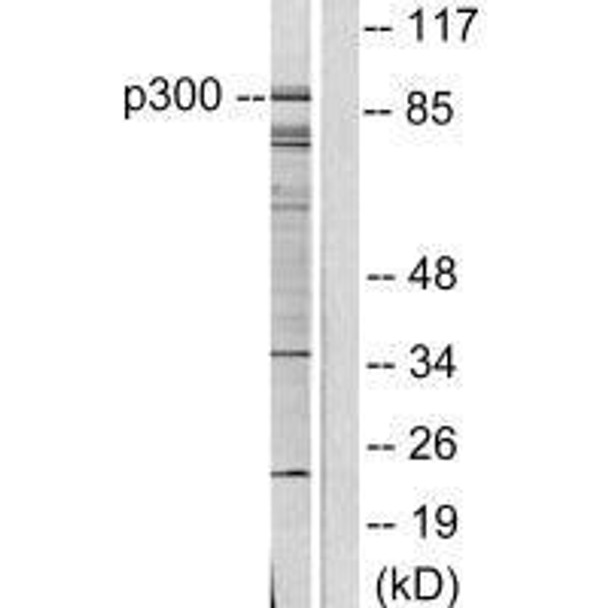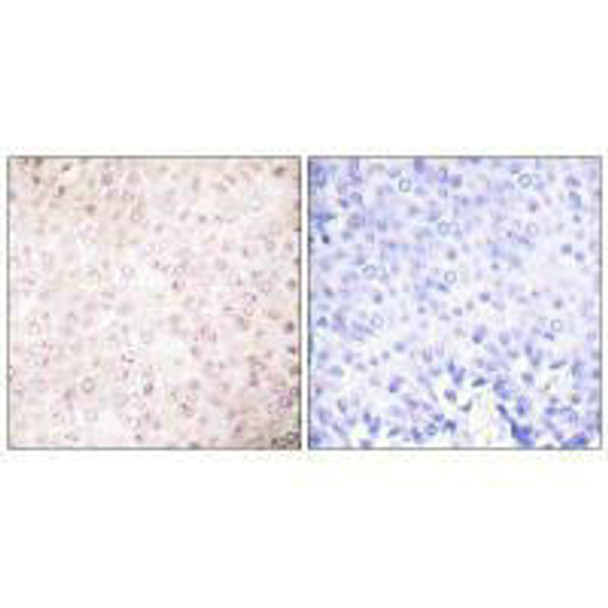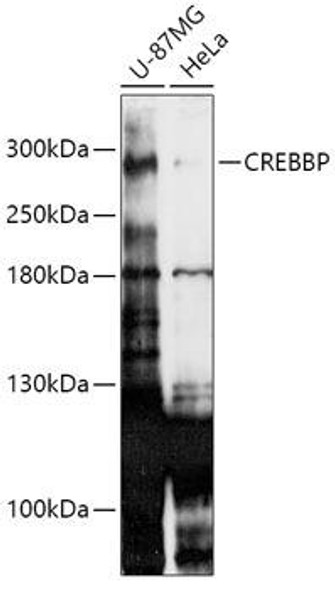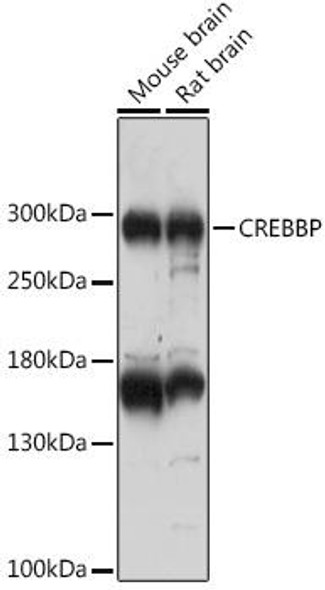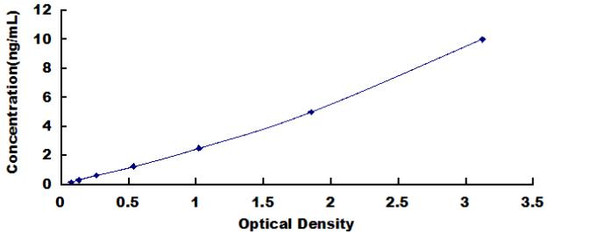Description
EP300/CREBBP Antibody (PACO23129)
The EP300/CREBBP Antibody (PAC023129) is a highly specific tool for researchers studying the proteins EP300 and CREBBP, which are crucial regulators of gene expression and cell signaling pathways. This rabbit polyclonal antibody is optimized for use in Western blot applications and has been validated for its specificity in detecting EP300 and CREBBP proteins in human samples.EP300 and CREBBP are transcriptional coactivators that play essential roles in a wide range of biological processes, including cell growth, differentiation, and apoptosis. Dysregulation of these proteins has been linked to various diseases, including cancer, neurodevelopmental disorders, and cardiovascular conditions.
By utilizing the EP300/CREBBP Antibody, researchers can investigate the role of these proteins in disease pathogenesis and explore potential therapeutic targets for intervention.This antibody is a valuable tool for immunology and cancer research, allowing for the accurate detection and analysis of EP300 and CREBBP proteins in various cell types and tissues. Its high reactivity and specificity make it an essential component in understanding the molecular mechanisms underlying disease development and progression.
| Antibody Name: | EP300/CREBBP Antibody (PACO23129) |
| Antibody SKU: | PACO23129 |
| Size: | 100ul |
| Host Species: | Rabbit |
| Tested Applications: | ELISA, WB, IHC |
| Recommended Dilutions: | ELISA:1:2000-1:10000, WB:1:500-1:3000, IHC:1:50-1:100 |
| Species Reactivity: | Human, Mouse, Rat |
| Immunogen: | Synthesized peptide derived from human P300/CBP. |
| Form: | Liquid |
| Storage Buffer: | Rabbit IgG in phosphate buffered saline (without Mg2+ and Ca2+), pH 7.4, 150mM NaCl, 0.02% sodium azide and 50% glycerol. |
| Purification Method: | The antibody was affinity-purified from rabbit antiserum by affinity-chromatography using epitope-specific immunogen. |
| Clonality: | Polyclonal |
| Isotype: | IgG |
| Conjugate: | Non-conjugated |
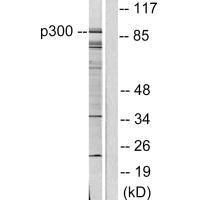 | Western blot analysis of extracts from COLO205 cells, using P300/CBP antibody. |
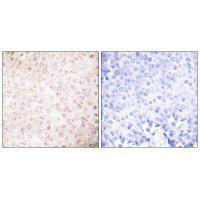 | Immunohistochemical analysis of paraffin-embedded human breast carcinoma tissue using P300/CBP antibody. |
| Background: | Acetylates histones, giving a specific tag for transcriptional activation. Also acetylates non-histone proteins, like NCOA3 and FOXO1. Binds specifically to phosphorylated CREB and enhances its transcriptional activity toward cAMP-responsive genes. Acts as a coactivator of ALX1 in the presence of EP300. Acts as a circadian transcriptional coactivator which enhances the activity of the circadian transcriptional activators: NPAS2-ARNTL/BMAL1 and CLOCK-ARNTL/BMAL1 heterodimers. |
| Synonyms: | CREB-binding protein; CREBBP E1A-associated protein p300; EP300; P300 transcription coactivator homolog; |
| UniProt Protein Function: | p300: a histone acetyltransferase and transcriptional co-activator that regulates transcription via chromatin remodeling. Acetylates all four core histones in nucleosomes. Related to CPB (CREB-binding protein), and like CPB can stimulate transcription through activation of CREB. Specifically inhibited by the adenovirus oncoprotein E1A. A co-activator of HIF1A (hypoxia-inducible factor 1 alpha), and thus plays a role in the stimulation of hypoxia-induced genes such as VEGF. Mediates cAMP-gene regulation by binding specifically to phosphorylated CREB protein. Methylated at R580 and R604 in the KIX domain by CARM1, which blocks association with CREB, inhibits CREB signaling and activates the apoptotic response. Also methylated at R2142 by CARM1, which impairs interaction with NCoA2. |
| UniProt Protein Details: | Protein type:Transcription, coactivator/corepressor; Motility/polarity/chemotaxis; EC 2.3.1.48; Nuclear receptor co-regulator; Acetyltransferase Chromosomal Location of Human Ortholog: 22q13.2 Cellular Component: cytoplasm; histone acetyltransferase complex; nucleoplasm; nucleus; transcription factor complex Molecular Function:acetyltransferase activity; androgen receptor binding; beta-catenin binding; chromatin binding; chromatin DNA binding; damaged DNA binding; DNA binding; histone acetyltransferase activity; lysine N-acetyltransferase activity; nuclear hormone receptor binding; p53 binding; protein binding; protein C-terminus binding; transcription activator binding; transcription coactivator activity; transcription factor binding; transferase activity, transferring acyl groups; zinc ion binding Biological Process: apoptosis; B cell differentiation; circadian rhythm; DNA damage response, signal transduction by p53 class mediator resulting in induction of apoptosis; DNA repair; establishment and/or maintenance of chromatin architecture; fat cell differentiation; G2/M transition of mitotic cell cycle; gene expression; heart development; innate immune response; internal peptidyl-lysine acetylation; internal protein amino acid acetylation; lung development; mitotic cell cycle; N-terminal peptidyl-lysine acetylation; negative regulation of transcription from RNA polymerase II promoter; nervous system development; Notch signaling pathway; nucleotide-excision repair; organ morphogenesis; platelet formation; positive regulation of gene expression, epigenetic; positive regulation of interferon type I production; positive regulation of protein binding; positive regulation of transcription factor activity; positive regulation of transcription from RNA polymerase II promoter; positive regulation of transcription of target genes involved in unfolded protein response; protein amino acid acetylation; protein stabilization; regulation of cell cycle; regulation of gene expression, epigenetic; regulation of transcription, DNA-dependent; response to estrogen stimulus; response to hypoxia; skeletal muscle development; somitogenesis; stimulatory C-type lectin receptor signaling pathway; transcription from RNA polymerase II promoter; transcription-coupled nucleotide-excision repair; viral reproduction Disease: Colorectal Cancer; Rubinstein-taybi Syndrome 1; Rubinstein-taybi Syndrome 2 |
| NCBI Summary: | This gene encodes the adenovirus E1A-associated cellular p300 transcriptional co-activator protein. It functions as histone acetyltransferase that regulates transcription via chromatin remodeling and is important in the processes of cell proliferation and differentiation. It mediates cAMP-gene regulation by binding specifically to phosphorylated CREB protein. This gene has also been identified as a co-activator of HIF1A (hypoxia-inducible factor 1 alpha), and thus plays a role in the stimulation of hypoxia-induced genes such as VEGF. Defects in this gene are a cause of Rubinstein-Taybi syndrome and may also play a role in epithelial cancer. [provided by RefSeq, Jul 2008] |
| UniProt Code: | Q09472 |
| NCBI GenInfo Identifier: | 223590203 |
| NCBI Gene ID: | 2033 |
| NCBI Accession: | Q09472.2 |
| UniProt Secondary Accession: | Q09472,B1AKC2, |
| UniProt Related Accession: | Q09472 |
| Molecular Weight: | 264,161 Da |
| NCBI Full Name: | Histone acetyltransferase p300 |
| NCBI Synonym Full Names: | E1A binding protein p300 |
| NCBI Official Symbol: | EP300 |
| NCBI Official Synonym Symbols: | p300; KAT3B; RSTS2 |
| NCBI Protein Information: | histone acetyltransferase p300 |
| UniProt Protein Name: | Histone acetyltransferase p300 |
| UniProt Synonym Protein Names: | E1A-associated protein p300 |
| Protein Family: | Histone acetyltransferase |
| UniProt Gene Name: | EP300 |
| UniProt Entry Name: | EP300_HUMAN |

